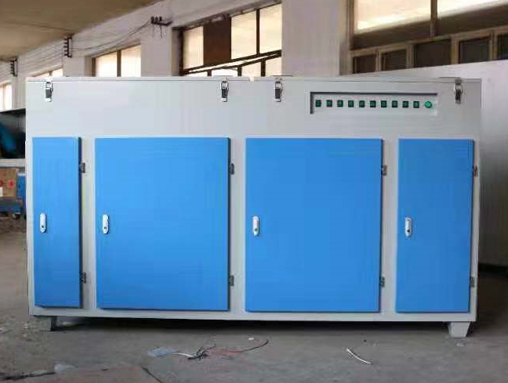UV photocatalytic oxygen purifier
UV photocatalytic oxygen purifier applicable industries and scope:
The treatment of odorous waste gases generated in spray painting workshops, ink printing, spray painting workshops, slaughterhouses, chemical, rubber, food, printing and dyeing, brewing, papermaking, oil refineries, sewage treatment plants, garbage transfer stations, etc.
The UV photocatalytic oxygen purifier is composed of a microwave generator, an ion ozone generator, a control box, a medium efficiency filter, a titanium dioxide photocatalyst, and an outer box.
The high-power ultraviolet discharge tube used in the UV photocatalytic oxygen purifier belongs to the low-pressure mercury discharge tube, and the emitted ultraviolet wavelengths are mainly 170nm and 184.9nm (currently researching the 150nm to 184.9nm wavelength series products), with photon energies of 742 KJ/mol and 647 KJ/mol, respectively. To break the molecular bonds of pollutant molecules, it is necessary to use photon energy that is stronger than the binding energy of pollutant molecules. Table 1 lists the binding energies of the main chemical molecules. According to Table 1, the molecular binding energy of most chemical substances is lower than the photon energy of 170nm and 184.9nm wavelength ultraviolet light. Therefore, this UV photolysis purifier can decompose most chemical substances except for carbon, calcium, and metals.
UV photocatalytic oxygen purifier technology uses a high-pressure electric field to ionize O2 in the air and produce O3, which has a much higher ozone production efficiency than UV lamps. But the plasma tube hardly emits ultraviolet light. Without the catalytic effect of ultraviolet radiation, the reaction between ozone and exhaust gas becomes slow and difficult in exhaust gas treatment devices that only use plasma technology, which also restricts the treatment efficiency of the equipment. UV photolysis utilizes the dual spectral characteristics of a low-pressure ultraviolet lamp that can simultaneously emit the 185nm ultraviolet band and the 254nm ultraviolet band. The 185nm ultraviolet light emitted by the lamp can trigger O2 (oxygen) in the air to be converted into O3 (ozone). Ozone has the ability to oxidize pollutants. After fully mixing and contacting with hydrocarbons (such as benzene, hydrocarbons, alcohols, lipids, etc.) in exhaust gas, it can directly oxidize and decompose these pollutants into water and carbon dioxide under the catalytic conditions of 254nm ultraviolet radiation emitted by the lamp. From this, it can be seen that the 185nm ultraviolet light emitted by the ultraviolet lamp serves to provide oxidation reactants; The 254nm ultraviolet light emitted by the lamp tube plays a role in providing favorable reaction conditions for the smooth progress of photolysis reaction. However, the ozone generation capacity of ultraviolet lamps is relatively low. For example, the commonly used 150W U-shaped ozone ultraviolet lamp, under sufficient oxygen conditions, produces about 900mg of ozone per hour, which means its unit power produces only 6mg/w of ozone per hour. As a major reactant in photolysis reactions, the amount of ozone produced directly affects the effectiveness of the treatment.
Glass lifter stamping parts series
Light Truck Blocker Series
New Energy Sheet Metal Parts Series
New energy vehicle parking bracket series
Dust collector series
 Analysis and Application of Stamping Parts and Precautions for Mold Forging
Analysis and Application of Stamping Parts and Precautions for Mold ForgingTo deal with problems caused by materials, manufacturing personnel can choose appropriate p...
 Key points of mold and tooling management for metal stamping equipment and mold
Key points of mold and tooling management for metal stamping equipment and moldRegular maintenance is implemented for tooling molds, and a mandatory pre repair system is ...
 Factors affecting the management of production materials and defects in stamping
Factors affecting the management of production materials and defects in stampingStrengthen the control and supervision of incoming stamping parts. For the stamping worksho...
 Modernization process upgrade and quality process monitoring management of metal
Modernization process upgrade and quality process monitoring management of metalThe manufacturing process level of chassis stamping parts in automobile production not only...
 Quality improvement measures and reasonable selection of equipment for metal sta
Quality improvement measures and reasonable selection of equipment for metal staStamping technology can be divided into two categories: separation process and forming proc...


